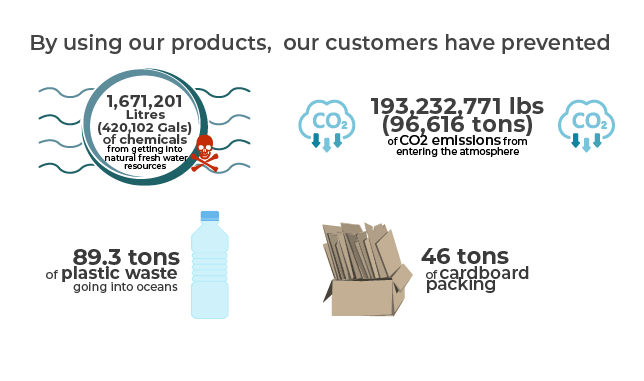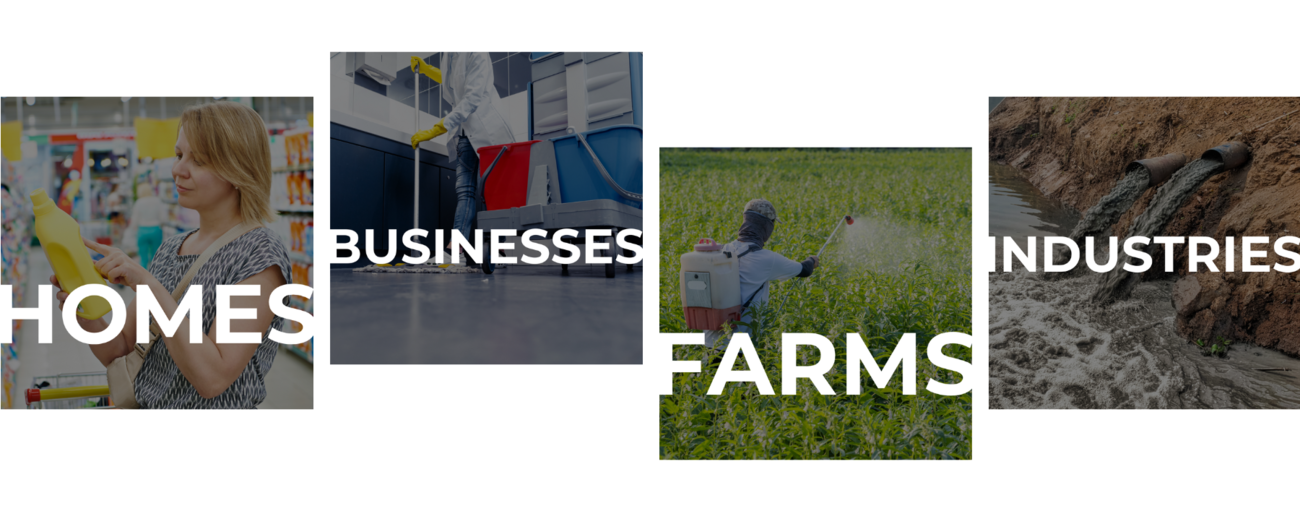
The Power of Collective Action
As we reflect on this past year, let's remember that it's your participation that fuels our joint mission. Every gallon of water treated and every pound of plastic and cardboard waste prevented starts with you. Your choices ripple outward, touching lives and safeguarding waters in ways you can see and cannot.
These following milestones are far more than numbers—they are the echo of our collective commitment to Saving the Planet's Water, Nature's Way.

Here's the change we've driven together, one green choice at a time:

Our WHY.
For over three decades, we have focused on a simple yet profound mission: Living better & and Saving the Planet’s Water, Nature’s Way.
The Driver of our Journey: Water Pollution
Before we talk about what we do, let's talk about what is water pollution and its causes.
Water pollution is caused by the introduction of harmful substances or contaminants into bodies of water, such as rivers, lakes, oceans, and groundwater. These contaminants can come from various sources and can have detrimental effects on aquatic ecosystems, human health, and the environment. Here are some common causes of water pollution:
Several substances directly pollute water resources, but some others pollute the air and ground. Nevertheless, a large amount of these pollutants entering the soil and air end up in our freshwater resources.
Here are some common ways in which homes, businesses, the farm industry and some other industries contribute water pollution.

Homes
Homes can contribute to water pollution in several ways, both directly and indirectly.
Sewage and Wastewater: If a home's sewage system is not properly maintained or connected to a malfunctioning sewage treatment system, untreated or inadequately treated sewage can be discharged into nearby water bodies, causing pollution.
Homes with septic systems can be sources of contamination if the septic system is not properly designed, and maintained, or if it fails. This can lead to the release of pathogens, nutrients, and chemicals into groundwater and surface water.
Household Chemicals and Cleaners: The improper disposal of household chemicals, such as paints, solvents, pesticides, and cleaning products, can lead to contamination of water bodies when these substances are dumped down drains, toilets, or into stormwater drains.
Toxic Lawn, Garden and Pond Care: The excessive use of fertilizers and pesticides on lawns and gardens can result in nutrient runoff and the introduction of chemicals into water bodies when it rains or when irrigation water runs off.
Herbicides and chemical treatments used in pond treatment: These products lead to eutrophication, over accumulation of nutrients in nearby water bodies. Over-reliance on chemical treatments can lead to the development of resistance in target organisms. This means that over time, the treatments become less effective, requiring higher doses or different chemicals.
Car Wash Runoff: Washing cars in driveways or streets can result in the release of oil, grease, and soap residues into stormwater drains, which can then flow into water bodies.
Businesses
Businesses impact freshwater resources through industrial discharges, energy production, construction activities, and commercial waste disposal. Manufacturing processes release heavy metals and toxic substances, causing direct contamination.
Businesses in the manufacturing and packaging industries can contribute to water pollution through the production and disposal of plastics, which often end up in oceans and rivers, breaking down into microplastics.
Harmful Cleaning Products: Many commercial cleaning products contain a range of chemicals, including surfactants, solvents, and disinfectants. Some of these chemicals may be toxic to aquatic life or can disrupt aquatic ecosystems.
Improper Disposal of Cleaning Wastewater: When businesses clean surfaces, equipment, or facilities with commercial cleaners, the wastewater generated can contain a variety of chemicals, detergents, and contaminants. If this wastewater is not properly managed or disposed of, it can enter stormwater drains or seep into the ground, ultimately finding its way into nearby water bodies, such as rivers, streams, or groundwater.
Construction sites: contribute sediment and waste materials to nearby water bodies.
Additionally, waste from commercial activities like restaurants can overload local sewage treatment facilities.
Farm Industry
Farm industry: Regarding the farm industry, livestock manure and fertilizers can contaminate freshwater when rain causes runoff. Fertilizers like phosphorus used for plant growth end up in the freshwater, promoting algae, weed and aquatic vegetation overgrowth, altering the natural balance.
Poor dugout management: Treating water bodies such as dugouts, ponds and lakes with chemicals can leave residues in the water, sediments, or aquatic organisms, potentially leading to long-term ecological effects. Continuous or frequent chemical treatments may exacerbate these issues and can leach into the surrounding environment, contaminating groundwater or nearby water bodies. This contamination can have far-reaching ecological and human health implications.
Animal manure and waste from livestock farming can also contribute to water contamination. Overgrazing, improper land management, and excessive irrigation can lead to soil erosion, sediment runoff, and nutrient pollution, all of which indirectly affect water quality.
Industries
Industries: In almost every industry, water is used for manufacturing processes, the production of raw materials, and energy production. Water picks up pollutants and chemicals in industrial cleaners. Even though the most toxic are treated along with sewage discharge, lots of it is discharged into the drainage system.
Mining Activities: Mining operations can release heavy metals, sediments, and toxic chemicals into nearby rivers and streams. These pollutants can have long-lasting effects on aquatic ecosystems.
Construction Activities: Construction sites can generate sediment runoff, as well as release chemicals and pollutants from construction materials and equipment.
Oil Spills: Accidental oil spills, often associated with transportation and the oil industry, can have devastating effects on marine ecosystems. Oil can coat the water's surface, harm aquatic life, and damage coastal environments.
Landfills and Dumping: Improper disposal of solid waste and hazardous materials in landfills or through illegal dumping can lead to groundwater contamination when leachate, a liquid that forms as waste breaks down, seeps into the soil and eventually reaches groundwater.
Pollution impacts in the food chain
Pollution is also causing significant problems in our food chain. Polluted water is used by animals like livestock and fish and for watering crops. The harmful chemicals in this water can build up in these animals' bodies, a process known as bioaccumulation. This means they end up with more of these toxic chemicals than they can get rid of.
At the same time, there's another process called biomagnification. It starts with tiny water plants like phytoplankton getting polluted. Small creatures eat these plants, and then bigger animals eat those smaller creatures. With each step up the food chain, the amount of pollution in the bodies of these animals increases. Eventually, this pollution reaches us humans when we eat these animals. This can lead to serious health issues, like kidney failure and nerve damage.
Knowing all this, we realized we had to tackle water pollution in two ways to save the planet's water as Nature's Way.
1- REMOVING pollution from water.
That is where our journey began, and the aim of cleaning water resources through water aeration systems and natural pond treatments that work in harmony with Nature's processes, instead of resorting to harsh chemicals.
We started by innovating windmill aeration and expanded to electric and solar systems to provide water with the oxygen needed to balance polluted or disrupted ecosystems.
Later on, we created the first all natural, all-in-one pond conditioner in North America, a blend of beneficial bacteria and enzymes that treat the water without harming ecosystems, entirely safe for the animals, the environment and humans. With this addition came a full product line in Pond Care.
2- REDUCING the amount of harmful chemicals getting in the water bodies.
Yet, we realized that our mission needed to go beyond just treating water, taking a step back and focusing on reducing the amount of pollutants entering our water resources. We expanded our focus to include:
-- Eco-Friendly Commercial Cleaning Products: Our ecosystems and health face a devastating impact because of harmful chemicals, such as phthalates, perchloroethylene, triclosan and ammonia, just some of the extensive list of chemicals, that surround us every day in our working and living environment.
We knew this situation wasn't quite right; we needed a solution to prevent this chemical from getting to our precious water resources and living places. Therefore, we created our products to mimic natural cleaning processes using beneficial bacteria and enzymes without resourcing harmful chemicals. We work with businesses to maintain cleanliness in their buildings while being environmental custodians and taking care of our ecosystem and employees' and customers' health.
-- Waste Water, Sewage and Septic Solutions: As the population grows, needs and waste grow with it. Industries are embracing environmental and social responsibility and looking for safe solutions. Our solutions for wastewater septic and sewage consist of adding specific and efficient pollutant-biodegrading microorganisms into a microbial community to enhance its ability to biodegrade contaminants; this process allows municipalities and businesses to approach their need in an efficient, effective and yet respectful way for the environment and stakeholders.
We work hand in hand with municipalities, golf courses, farmers, industrial organizations, fish farms, land and homeowners by harmonizing high-performance care with environmental responsibility.
Our commitment to manufacturing and innovating green, safe products remains unwavering. We aim to empower our customers to achieve their green goals effectively. Every solution we offer at Koenders Water Solutions and Nature's Pond is a step towards ecological balance.

We will keep developing solutions that prioritize the health of people and the planet while empowering customers by providing them with actionable solutions toward their green ambitions.
Thank you for standing with Koenders Water Solutions and Nature's Pond. Together, we're shaping a future where every drop of water tells the story of our care, our love, and our unwavering dedication to the planet's most precious resource.
Here's to the continued journey of "Living better and Saving the Planet's Water, Nature's Way.